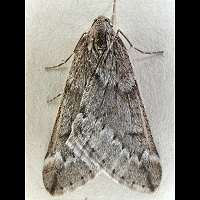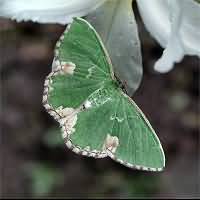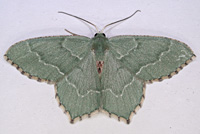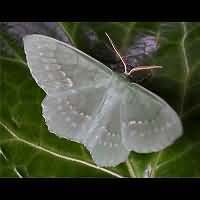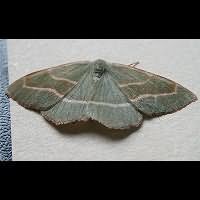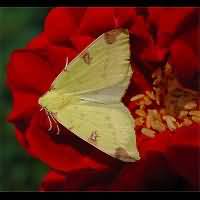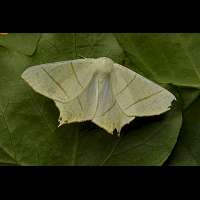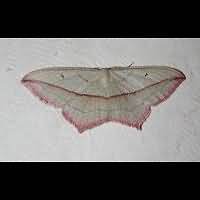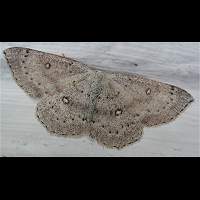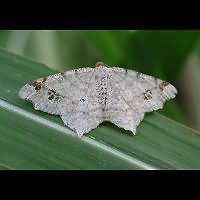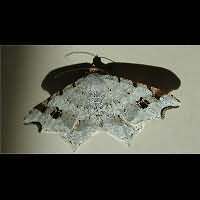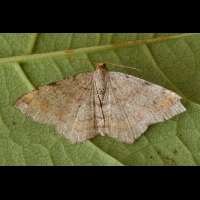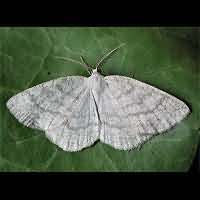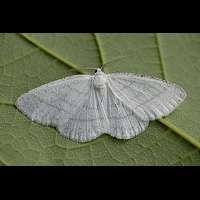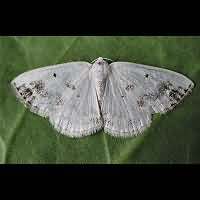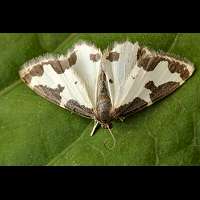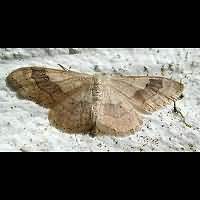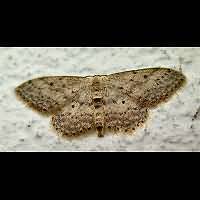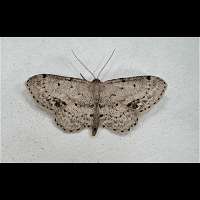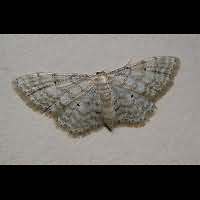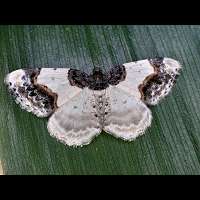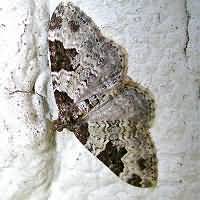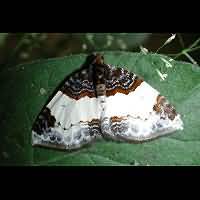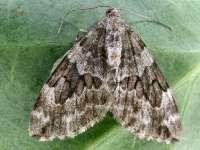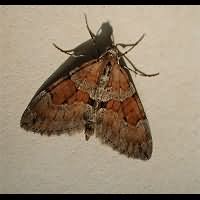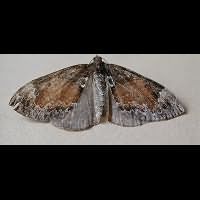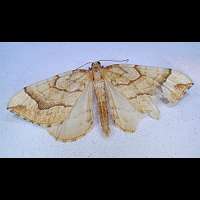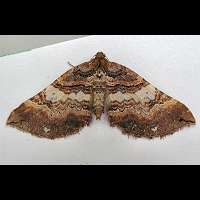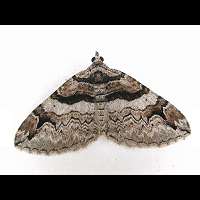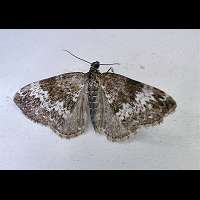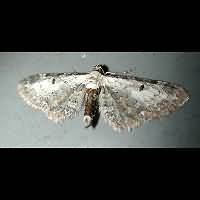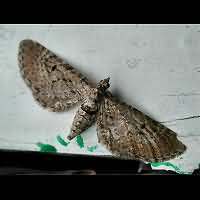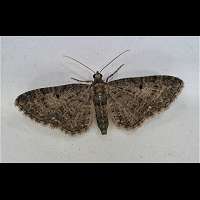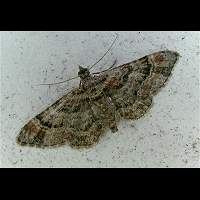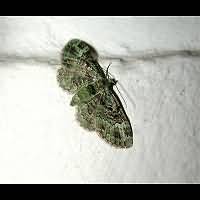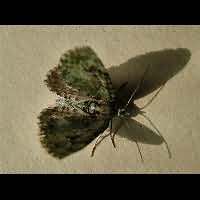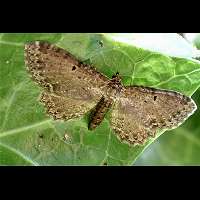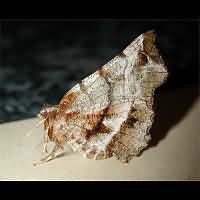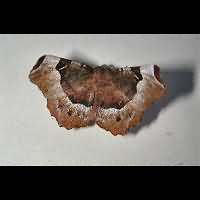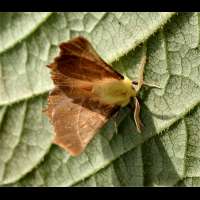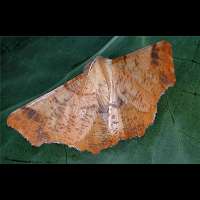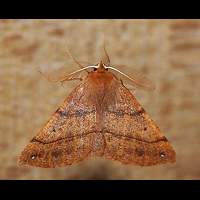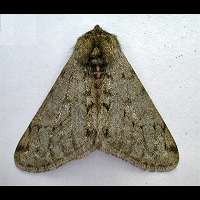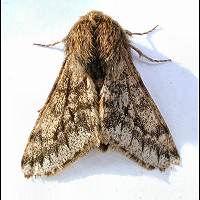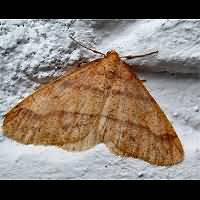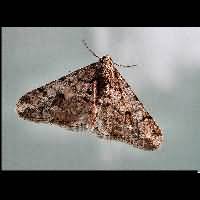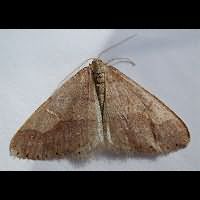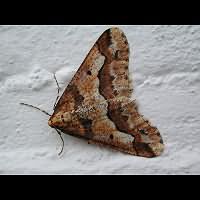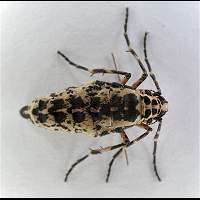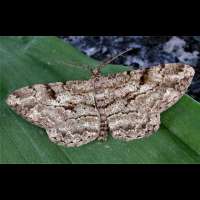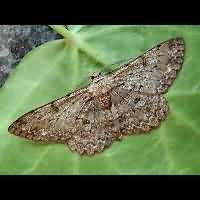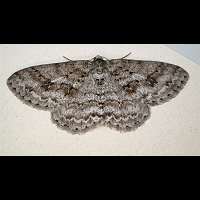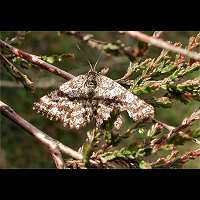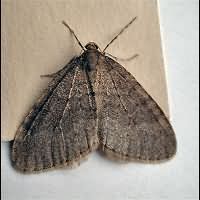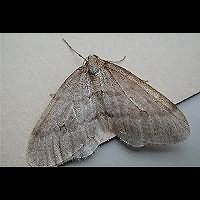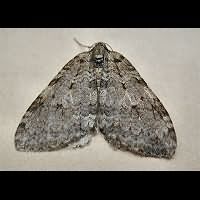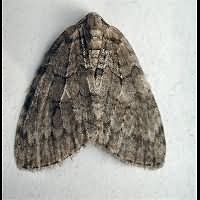[All pictures of garden wildlife on this page are thumbnails. Click on any thumbnail for a large format to be displayed.]
Some families of moths are not named after their imago (=the adults that can fly), but after their caterpillars. Moths and butterflies go through the full circle of life of an insect: egg, caterpillar, pupa and imago. Eggs and pupae are rather indistinct with no striking and unique features that can be used to name the animals. Caterpillars and imagos are in motion and are thus fascinating to men than eggs and pupas. Some moths are named after their caterpillars because these are even more interesting than the adults. This certainly applies to the Geometer Worms: they can erect themselves to look just like a twig. And when they move they bring the back of the body towards the front, forming a kind of curl. Then they lift the front up to the position that they form one straight line. There are plenty of them in almost all gardens, but many are small and difficult to detect. In this family of moths we find a few species that fly in late fall and, unless it's too cold, even in winter.
March Moth Alsophila aescularia
Curiously shaped Geometer, looking rather like an overgrown moth. More...
Curiously shaped Geometer, looking rather like an overgrown moth. More...
Common Emerald Hemithea aestivaria
No blotches on the main part of the wings, but the fringes are blotched. More...
No blotches on the main part of the wings, but the fringes are blotched. More...
Large Emerald Geometra papilionaria
A very big species. The usual lines are replaced bij dots. More...
A very big species. The usual lines are replaced bij dots. More...
Light Emerald Campaea margaritata
This green species quickly turns into white. The green and white line is characteristic More...
This green species quickly turns into white. The green and white line is characteristic More...
Barred Red Hylaea fasciaria
In Britain usually dull red and not green. The green variation is about as common as the red one on the continent, though. More...
In Britain usually dull red and not green. The green variation is about as common as the red one on the continent, though. More...
Brimstone Moth Opisthograptis luteolata
Such colourful the Brimstone Butterfly will give you no problems identifying it. More...
Such colourful the Brimstone Butterfly will give you no problems identifying it. More...
Swallow-tailed Moth Ourapteryx sambucaria
The common name of this species tells you about its striking feauters. More...
The common name of this species tells you about its striking feauters. More...
Blood Vein Timandra comae
The blood vein in the Blood Vein runs from one wing tip to the other wing tip. More...
The blood vein in the Blood Vein runs from one wing tip to the other wing tip. More...
Maiden's Blush Moth Cyclophora punctaria
Speckled species with blushes and a dark line, not beginning at the tip of the wing but somewhere half way the wing. More...
Speckled species with blushes and a dark line, not beginning at the tip of the wing but somewhere half way the wing. More...
Birch Mocha Cyclophora albipunctata
The delicate pattern on the Birch Mocha makes it a beautiful Geometer. More...
The delicate pattern on the Birch Mocha makes it a beautiful Geometer. More...
Sharp-angled Peacock Macaria alternata
The notch in this forewing has a thick almost black colour. More...
The notch in this forewing has a thick almost black colour. More...
Common Wave Cabera exanthemata
Similar to the Common White Wave, but the outer line is slightly bended and not straight. More...
Similar to the Common White Wave, but the outer line is slightly bended and not straight. More...
Common White Wave Cabera pusaria
Similar to the Common Wave but the outer line runs straight. More...
Similar to the Common Wave but the outer line runs straight. More...
Clouded Silver Lomographa temerata
It is easy to identify this species, even though the cloud varies in size. More...
It is easy to identify this species, even though the cloud varies in size. More...
Clouded Border Lomaspilis marginata
An all white species with a very variable darkly marked border. More...
An all white species with a very variable darkly marked border. More...
Riband Wave Idaea aversata
Not an easy species this Wave, but it is the biggest of them all. More...
Not an easy species this Wave, but it is the biggest of them all. More...
Single-dotted Wave Idaea dimidiata
On the upper wing is a single dot and some dark markings near the inner wing tip. More...
On the upper wing is a single dot and some dark markings near the inner wing tip. More...
Dwarf Cream Wave Idaea fuscovenosa
Has four black dots: one on each wing and usually the base of the leading edge of the forewing is brownish. More...
Has four black dots: one on each wing and usually the base of the leading edge of the forewing is brownish. More...
Scorched Carpet Ligdia adustata
Unmistakable species: beautiful and mind the light wing tip. More...
Unmistakable species: beautiful and mind the light wing tip. More...
Garden Carpet Moth Xanthorhoe fluctuata
Species with many variations. The band in the middle of the wing starts off keenly, but ends in one big deception. More...
Species with many variations. The band in the middle of the wing starts off keenly, but ends in one big deception. More...
Beautiful Carpet Mesoleuca albicillata
Beautiful species. There are hardly any similar species around. More...
Beautiful species. There are hardly any similar species around. More...
Flame Carpet Xanthorhoe designata
Very variable species. Both reddish band and black dot may be missing. More...
Very variable species. Both reddish band and black dot may be missing. More...
Spruce Carpet Thera variata and Thera britannica
These two species can only be told apart by close examination of the genitals. More...
These two species can only be told apart by close examination of the genitals. More...
Grey Pine Carpet Thera obeliscata
When it is reddish it is this species. When it is grey it is either this species or a Spruce Carpet. Difficult to tell, actually. More...
When it is reddish it is this species. When it is grey it is either this species or a Spruce Carpet. Difficult to tell, actually. More...
Red Twin-spot Carpet Xanthorhoe ferrugata
Dark-barred Twin-spot Carpet Xanthorhoe spadicearia
The Red Twin-spot Carpet and the Dark-barred Twin-spot Carpet can not be told apart as a rule. More...
Dark-barred Twin-spot Carpet Xanthorhoe spadicearia
The Red Twin-spot Carpet and the Dark-barred Twin-spot Carpet can not be told apart as a rule. More...
Shoulder Stripe Anticlea badiata
The combination of markings and colours soon gives this one away. More...
The combination of markings and colours soon gives this one away. More...
Barberry Carpet Pareulype berberata
Identification of this species is easy. You'll find it mainly in parks and gardens. More...
Identification of this species is easy. You'll find it mainly in parks and gardens. More...
Small Rivulet Perizoma alchemillata
Extremely small Geometer reaching a wingspan of no more than 25 mm! More...
Extremely small Geometer reaching a wingspan of no more than 25 mm! More...
Bordered Pug Eupithecia succenturiata
The big white part of the wings makes this one of the easiest species to identify of all pugs. More...
The big white part of the wings makes this one of the easiest species to identify of all pugs. More...
Freyer's Pug Eupithecia intricata
Extremely difficult species to identify, for it is very variable. The black spot on the wing helps a bit. It is not a dot but rather a very short line. More...
Extremely difficult species to identify, for it is very variable. The black spot on the wing helps a bit. It is not a dot but rather a very short line. More...
Dwarfpug Eupithecia tantillaria
Numerous white lines (but alas not always visible) and the size (this is one of the smallest pugs) should help in identifying this one. More...
Numerous white lines (but alas not always visible) and the size (this is one of the smallest pugs) should help in identifying this one. More...
Brindled Pug Eupithecia abbreviata
Usually the vein running near the inner edge of the wing is ochreous or brownish in this species. More...
Usually the vein running near the inner edge of the wing is ochreous or brownish in this species. More...
Golden-rod Pug Eupithecia virgaureata
The Golden-rod Pug is usually more lively marked than the very similar Grey Pug. More...
The Golden-rod Pug is usually more lively marked than the very similar Grey Pug. More...
Double-striped Pug Gymnoscelis rufifasciata
One of the very few pugs showing reddish brown patches. Most others are greyish or greyish brown. More...
One of the very few pugs showing reddish brown patches. Most others are greyish or greyish brown. More...
Green Pug Rhinoprora rectangulata
There is a clearly marked band on the underside of the forewing, something not seen in the V-pug. More...
There is a clearly marked band on the underside of the forewing, something not seen in the V-pug. More...
V-pug Chloroclystis v-ata
Like the name suggests, there's a clear V-shaped marking in black on the forewings. More...
Like the name suggests, there's a clear V-shaped marking in black on the forewings. More...
Purple Thorn Selenia tetralunaria
Easily identified by the half moon figure in the forewing, best seen at the underside of the wing. More...
Easily identified by the half moon figure in the forewing, best seen at the underside of the wing. More...
Canary-shouldered Thorn Ennomos alniaria
The extremely hairy, bright yellow body makes this species umistakable. More...
The extremely hairy, bright yellow body makes this species umistakable. More...
Large Thorn Ennomos autumnaria
The females are the biggest thorns around and both males and females have a dark spot near the tip of the wing. More...
The females are the biggest thorns around and both males and females have a dark spot near the tip of the wing. More...
September Thorn Ennomos erosaria
The September Thorn is not canary yellow and has no dark spots in the tip of the wing. More...
The September Thorn is not canary yellow and has no dark spots in the tip of the wing. More...
Scalloped Oak Crocallis elinguaria
Identifiable by the black dot and the resting pose: the wings are held horizontally but do not touch the surface the insect is sitting on. More...
Identifiable by the black dot and the resting pose: the wings are held horizontally but do not touch the surface the insect is sitting on. More...
Pale Brindled Beauty Phigalia pilosaria
This dull and owlet like geometer isn't an easy species to put a name on. More...
This dull and owlet like geometer isn't an easy species to put a name on. More...
Small Brindled Beauty Apocheima hispidaria
Looks like the Pale Brindled Beauty, but there is some grey near the edge of the wings. More...
Looks like the Pale Brindled Beauty, but there is some grey near the edge of the wings. More...
Oak Beauty Biston strataria
Heavily built, big geometer, on the wing in early spring. Males and females differ a lot. More...
Heavily built, big geometer, on the wing in early spring. Males and females differ a lot. More...
Peppered Moth Biston betularia
May look peppered indeed, but many animals are just dark and almost unmarked (melanism). More...
May look peppered indeed, but many animals are just dark and almost unmarked (melanism). More...
Spring Usher Agriopis leucophaearia
Extremely variable species. So be sure to look at the various pictures of this species. More...
Extremely variable species. So be sure to look at the various pictures of this species. More...
Dotted Border Agriopis marginaria
Has a row of dots near but not on the edge of the forewings. More...
Has a row of dots near but not on the edge of the forewings. More...
Mottled Umber Moth male Erannis defoliaria
The most variable of all Geometers. Sometimes beautifully and clearly marked sometimes entirely unmarked. More...
The most variable of all Geometers. Sometimes beautifully and clearly marked sometimes entirely unmarked. More...
Mottled Umber Moth female Erannis defoliaria
The females are entirely wingless. They do not even have the stumps so characteristic of most other winter geometers. More...
The females are entirely wingless. They do not even have the stumps so characteristic of most other winter geometers. More...
Pale Oak Beauty Hypomecis punctinali
There is a little circle on the lower wing which makes distinguishable. More...
There is a little circle on the lower wing which makes distinguishable. More...
Engrailed Moth Ectropis crepuscularia
Unique fork-shape markings on the forewings give this one away. More...
Unique fork-shape markings on the forewings give this one away. More...
Winter Moth Operophtera brumata
Almost identical to the Northern Winter Moth, but usually slightly darker and never shiny. More...
Almost identical to the Northern Winter Moth, but usually slightly darker and never shiny. More...
Northern Winter Moth Operophtera fagata
The twin of Winter Moth, but always a bit shiny, a little silky. More...
The twin of Winter Moth, but always a bit shiny, a little silky. More...
Autumnal Moth Epirrita autumnata
Variable and almost impossible to tell apart from similar species. More...
Variable and almost impossible to tell apart from similar species. More...

© Copyright 1998-2024 gardensafari.net (Hania Berdys)

 English / engels
English / engels  Dutch / nederlands
Dutch / nederlands